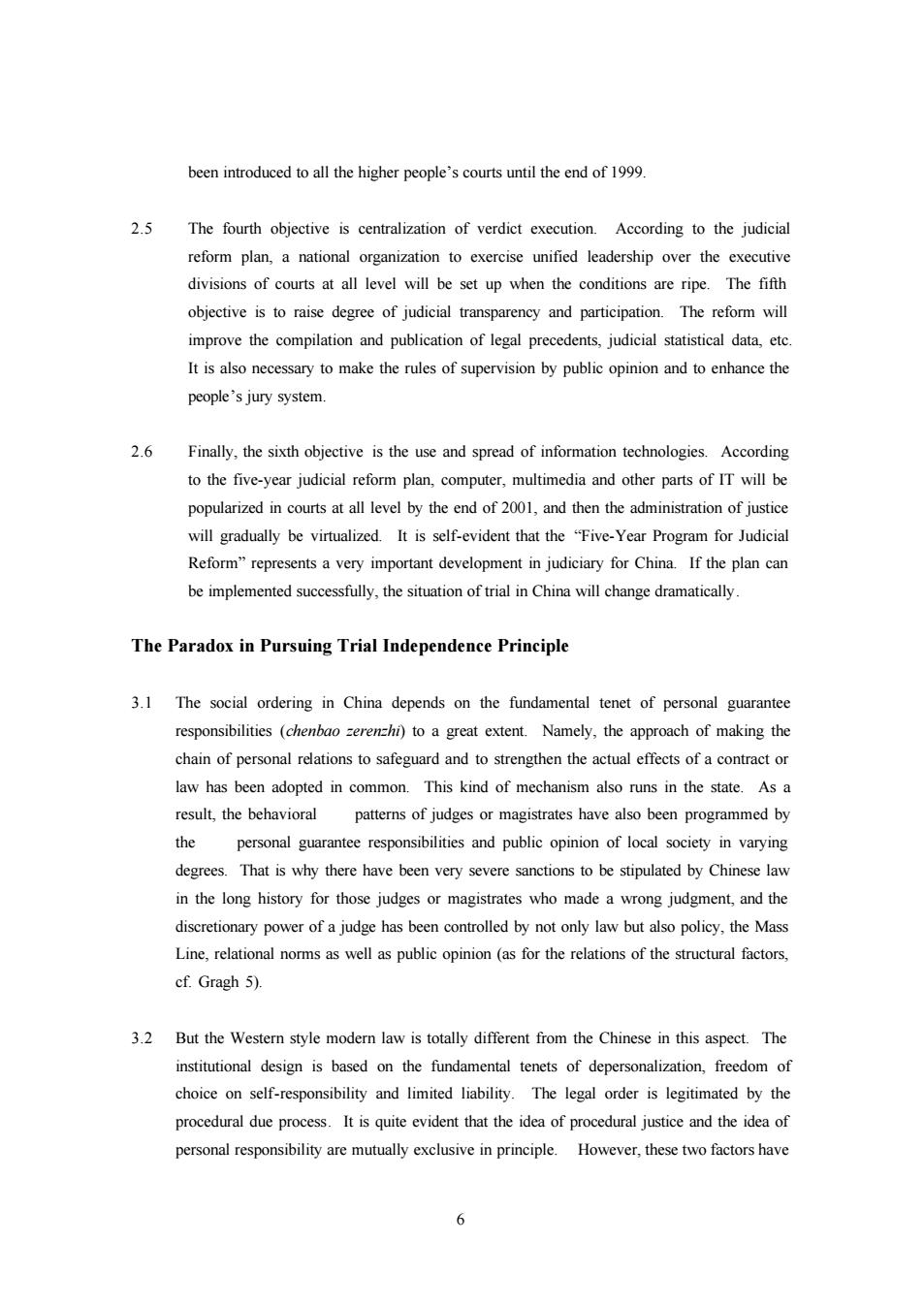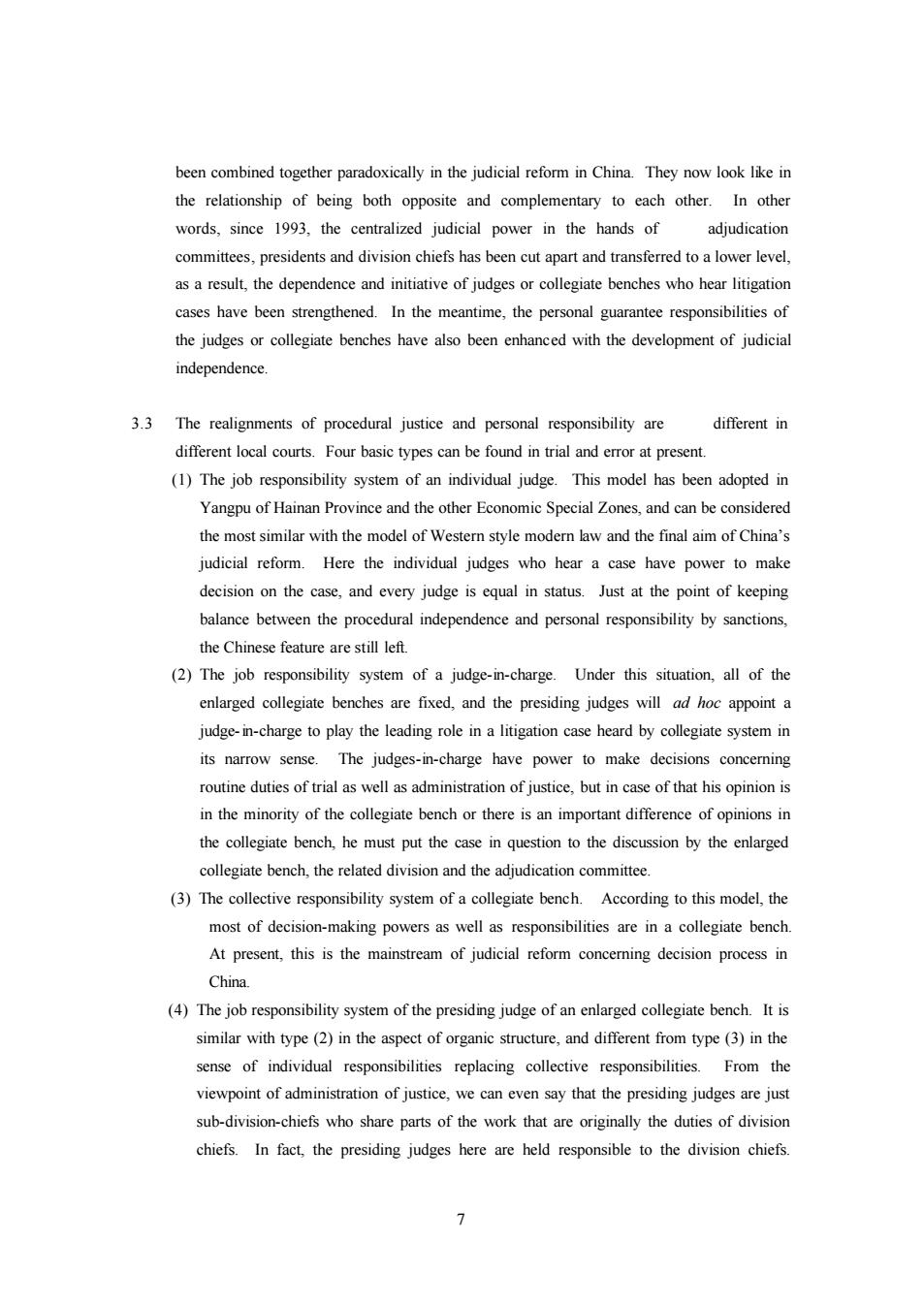
been introduced to all the higher people's courts until the end of 1999 2.5 The fourth objective is centralization of verdict execution.According to the judicial reform plan,a national organization to exercise unified leadership over the executive divisions of courts at all level will be set up when the conditions are ripe.The fifth objective is to raise degree of judicial transparency and participation.The reform will improve the compilation and publication of legal precedents,judicial statistical data,etc. It is also necessary to make the rules of supervision by public opinion and to enhance the people's jury system. 2.6 Finally,the sixth objective is the use and spread of information technologies.According to the five-year judicial reform plan,computer,multimedia and other parts of IT will be popularized in courts at all level by the end of 2001,and then the administration of justice will gradually be virtualized.It is self-evident that the "Five-Year Program for Judicial Reform"represents a very important development in judiciary for China.If the plan can be implemented successfully,the situation of trial in China will change dramatically. The Paradox in Pursuing Trial Independence Principle 3.1 The social ordering in China depends on the fundamental tenet of personal guarantee responsibilities (chenbao zerenzhi)to a great extent.Namely,the approach of making the chain of personal relations to safeguard and to strengthen the actual effects of a contract or law has been adopted in common.This kind of mechanism also runs in the state.As a result,the behavioral patterns of judges or magistrates have also been programmed by the personal guarantee responsibilities and public opinion of local society in varying degrees.That is why there have been very severe sanctions to be stipulated by Chinese law in the long history for those judges or magistrates who made a wrong judgment,and the discretionary power of a judge has been controlled by not only law but also policy,the Mass Line,relational norms as well as public opinion(as for the relations of the structural factors, cf.Gragh 5). 3.2 But the Western style modern law is totally different from the Chinese in this aspect.The institutional design is based on the fundamental tenets of depersonalization,freedom of choice on self-responsibility and limited liability.The legal order is legitimated by the procedural due process.It is quite evident that the idea of procedural justice and the idea of personal responsibility are mutually exclusive in principle.However,these two factors have 6
6 been introduced to all the higher people’s courts until the end of 1999. 2.5 The fourth objective is centralization of verdict execution. According to the judicial reform plan, a national organization to exercise unified leadership over the executive divisions of courts at all level will be set up when the conditions are ripe. The fifth objective is to raise degree of judicial transparency and participation. The reform will improve the compilation and publication of legal precedents, judicial statistical data, etc. It is also necessary to make the rules of supervision by public opinion and to enhance the people’s jury system. 2.6 Finally, the sixth objective is the use and spread of information technologies. According to the five-year judicial reform plan, computer, multimedia and other parts of IT will be popularized in courts at all level by the end of 2001, and then the administration of justice will gradually be virtualized. It is self-evident that the “Five-Year Program for Judicial Reform” represents a very important development in judiciary for China. If the plan can be implemented successfully, the situation of trial in China will change dramatically. The Paradox in Pursuing Trial Independence Principle 3.1 The social ordering in China depends on the fundamental tenet of personal guarantee responsibilities (chenbao zerenzhi) to a great extent. Namely, the approach of making the chain of personal relations to safeguard and to strengthen the actual effects of a contract or law has been adopted in common. This kind of mechanism also runs in the state. As a result, the behavioral patterns of judges or magistrates have also been programmed by the personal guarantee responsibilities and public opinion of local society in varying degrees. That is why there have been very severe sanctions to be stipulated by Chinese law in the long history for those judges or magistrates who made a wrong judgment, and the discretionary power of a judge has been controlled by not only law but also policy, the Mass Line, relational norms as well as public opinion (as for the relations of the structural factors, cf. Gragh 5). 3.2 But the Western style modern law is totally different from the Chinese in this aspect. The institutional design is based on the fundamental tenets of depersonalization, freedom of choice on self-responsibility and limited liability. The legal order is legitimated by the procedural due process. It is quite evident that the idea of procedural justice and the idea of personal responsibility are mutually exclusive in principle. However, these two factors have

been combined together paradoxically in the judicial reform in China.They now look like in the relationship of being both opposite and complementary to each other.In other words,since 1993,the centralized judicial power in the hands of adjudication committees,presidents and division chiefs has been cut apart and transferred to a lower level, as a result,the dependence and initiative of judges or collegiate benches who hear litigation cases have been strengthened.In the meantime,the personal guarantee responsibilities of the judges or collegiate benches have also been enhanced with the development of judicial independence. 3.3 The realignments of procedural justice and personal responsibility are different in different local courts.Four basic types can be found in trial and error at present. (1)The job responsibility system of an individual judge.This model has been adopted in Yangpu of Hainan Province and the other Economic Special Zones,and can be considered the most similar with the model of Western style modern law and the final aim of China's judicial reform.Here the individual judges who hear a case have power to make decision on the case,and every judge is equal in status.Just at the point of keeping balance between the procedural independence and personal responsibility by sanctions, the Chinese feature are still left. (2)The job responsibility system of a judge-in-charge.Under this situation,all of the enlarged collegiate benches are fixed,and the presiding judges will ad hoc appoint a judge-in-charge to play the leading role in a litigation case heard by collegiate system in its narrow sense.The judges-in-charge have power to make decisions concerning routine duties of trial as well as administration of justice,but in case of that his opinion is in the minority of the collegiate bench or there is an important difference of opinions in the collegiate bench,he must put the case in question to the discussion by the enlarged collegiate bench,the related division and the adjudication committee. (3)The collective responsibility system of a collegiate bench.According to this model,the most of decision-making powers as well as responsibilities are in a collegiate bench. At present,this is the mainstream of judicial reform concerning decision process in China. (4)The job responsibility system of the presiding judge of an enlarged collegiate bench.It is similar with type(2)in the aspect of organic structure,and different from type(3)in the sense of individual responsibilities replacing collective responsibilities.From the viewpoint of administration of justice,we can even say that the presiding judges are just sub-division-chiefs who share parts of the work that are originally the duties of division chiefs.In fact,the presiding judges here are held responsible to the division chiefs. 7
7 been combined together paradoxically in the judicial reform in China. They now look like in the relationship of being both opposite and complementary to each other. In other words, since 1993, the centralized judicial power in the hands of adjudication committees, presidents and division chiefs has been cut apart and transferred to a lower level, as a result, the dependence and initiative of judges or collegiate benches who hear litigation cases have been strengthened. In the meantime, the personal guarantee responsibilities of the judges or collegiate benches have also been enhanced with the development of judicial independence. 3.3 The realignments of procedural justice and personal responsibility are different in different local courts. Four basic types can be found in trial and error at present. (1) The job responsibility system of an individual judge. This model has been adopted in Yangpu of Hainan Province and the other Economic Special Zones, and can be considered the most similar with the model of Western style modern law and the final aim of China’s judicial reform. Here the individual judges who hear a case have power to make decision on the case, and every judge is equal in status. Just at the point of keeping balance between the procedural independence and personal responsibility by sanctions, the Chinese feature are still left. (2) The job responsibility system of a judge-in-charge. Under this situation, all of the enlarged collegiate benches are fixed, and the presiding judges will ad hoc appoint a judge-in-charge to play the leading role in a litigation case heard by collegiate system in its narrow sense. The judges-in-charge have power to make decisions concerning routine duties of trial as well as administration of justice, but in case of that his opinion is in the minority of the collegiate bench or there is an important difference of opinions in the collegiate bench, he must put the case in question to the discussion by the enlarged collegiate bench, the related division and the adjudication committee. (3) The collective responsibility system of a collegiate bench. According to this model, the most of decision-making powers as well as responsibilities are in a collegiate bench. At present, this is the mainstream of judicial reform concerning decision process in China. (4) The job responsibility system of the presiding judge of an enlarged collegiate bench. It is similar with type (2) in the aspect of organic structure, and different from type (3) in the sense of individual responsibilities replacing collective responsibilities. From the viewpoint of administration of justice, we can even say that the presiding judges are just sub-division-chiefs who share parts of the work that are originally the duties of division chiefs. In fact, the presiding judges here are held responsible to the division chiefs